fragrance concentration guide
Understanding fragrance concentration is key to selecting the perfect scent, as it impacts longevity and intensity, catering to personal preferences and occasions, while balancing top, middle, and base notes.
1;1 Understanding Fragrance Concentrations
Fragrance concentrations determine the strength and longevity of a scent, varying from intense parfum to light eau fraîche. Higher concentrations contain more essential oils, offering richer, longer-lasting aromas, while lower concentrations are lighter and more subtle. This guide explores how these levels, such as parfum, eau de parfum, and eau de toilette, are defined and their impact on fragrance experience. Understanding these differences helps in selecting the right scent for personal preferences, occasions, and environments, ensuring a harmonious balance between potency and subtlety.
1.2 Importance of Fragrance Strength in Perfumery
Fragrance strength plays a crucial role in perfumery, influencing both the longevity and character of a scent. Stronger concentrations, like parfum, offer depth and longevity, making them ideal for evening wear. Weaker concentrations, such as eau de toilette, are lighter and more refreshing, suitable for daytime use. The right strength ensures the fragrance complements the wearer without overwhelming others, balancing personal style with environmental appropriateness. This balance is essential for creating memorable yet wearable scents that resonate with individual preferences and cultural norms.
Standard Fragrance Concentrations
Fragrance concentrations vary, with options like parfum, eau de parfum, eau de toilette, and eau fraîche, each offering different levels of intensity and longevity for diverse preferences and occasions.
2.1 Parfum (Extrait de Parfum)
Parfum, or extrait de parfum, is the most concentrated fragrance form, typically containing 15-30% essential oils. It offers a rich, intense scent that lasts throughout the day, making it ideal for special occasions or personal enjoyment. The high concentration ensures a deep, complex aroma profile, often favored by perfume connoisseurs. Due to its potency, only a small amount is needed for long-lasting fragrance. Parfum is usually more expensive than other concentrations, reflecting the quality and quantity of premium ingredients used in its creation.
2.2 Eau de Parfum (EDP)
Eau de Parfum (EDP) is a popular fragrance concentration, containing 10-15% essential oils. It offers a balanced scent that typically lasts 6-8 hours, making it suitable for everyday use. EDP is lighter than parfum but more potent than eau de toilette, providing a subtle yet noticeable aroma. Its versatility makes it ideal for various occasions, from casual outings to professional settings. The moderate concentration ensures longevity without overwhelming the senses, appealing to a wide range of fragrance enthusiasts seeking a reliable and elegant scent option.
2.3 Eau de Toilette (EDT)
Eau de Toilette (EDT) is a lighter fragrance concentration, typically containing 5-15% essential oils, with an average of 10-12%. It offers a fresh, subtle scent that lasts about 4-6 hours. EDT is ideal for daytime use or casual events, as its lighter composition is less overpowering. Its affordability and versatility make it a popular choice for everyday wear. EDT is often preferred by those who enjoy a delicate fragrance without the intensity of stronger concentrations, appealing to a broad audience seeking a refreshing and easy-to-wear scent option.
2.4 Eau de Cologne (EDC)
Eau de Cologne (EDC) is a light and refreshing fragrance with a concentration of 3-5% essential oils. Originating in Cologne, Germany, it is traditionally citrus-based, offering a crisp and invigorating scent. EDC is perfect for everyday use, especially in warmer climates or during the day. Its light nature makes it less long-lasting, typically lasting 2-3 hours. EDC is a popular choice for those who prefer a subtle, non-overpowering fragrance. Its lower concentration also makes it a great option for individuals with sensitive skin or for layering with other scents.
2.5 Eau Fraîche
Eau Fraîche is the lightest fragrance concentration, typically containing 1-3% essential oils. It is characterized by its fresh, aqueous scent, often featuring citrus or herbal notes. This concentration is highly volatile, lasting only 1-2 hours on the skin. Eau Fraîche is ideal for everyday use, especially in warm weather, as it provides a subtle and refreshing fragrance. Its light nature makes it suitable for those who prefer delicate scents or have sensitive skin, offering a clean and revitalizing aroma without overwhelming the senses.
How Fragrance Concentration is Measured
Fragrance concentration is measured by the percentage of essential oils in the formula, typically ranging from 1% to 30%. Higher concentrations indicate more fragrance oils, resulting in longer-lasting scents.
3.1 The Role of Essential Oils in Concentration
Essential oils are the pure plant extracts that form the core of a fragrance. Their concentration determines the strength and longevity of the scent. Higher concentrations of essential oils result in more potent and longer-lasting fragrances, typically found in parfum or extrait de parfum. The quality and quantity of these oils directly impact the fragrance’s character and staying power. Essential oils are volatile, meaning they evaporate quickly, which is why their concentration is crucial for the perfume’s overall performance and appeal.
3.2 Dilution Ratios in Perfume Making
Dilution ratios are critical in determining fragrance concentration. Essential oils are typically mixed with alcohol and water, with the ratio of oil to solvent defining the strength. Higher concentrations, like parfum, use less solvent, while lighter ones, such as eau de toilette, are more diluted. The ratio directly impacts scent longevity and intensity. Perfumers carefully balance these ratios to achieve the desired fragrance profile, ensuring the scent unfolds smoothly without overpowering the wearer. Proper dilution ensures stability and consistency in the final product.
Fragrance Pyramid and Its Impact on Concentration
The fragrance pyramid consists of top, middle, and base notes, each with varying volatility. Concentration levels influence how these layers unfold, affecting scent longevity and intensity.
4.1 Top Notes and Their Volatility
Top notes are the initial, immediate scents in a fragrance, typically light and fresh. They are composed of small, volatile molecules that evaporate quickly, lasting only minutes. These notes set the first impression and are crucial for attracting attention. Their volatility directly impacts fragrance concentration, as they fade faster than middle or base notes. In higher concentrations like parfum, top notes may be less pronounced, while in lighter forms like eau de cologne, they dominate the scent profile due to their higher proportion of volatile ingredients.
4.2 Middle Notes (Heart Notes) and Their Role
Middle notes, or heart notes, emerge after the top notes fade, typically within 15-30 minutes. These richer, deeper scents add complexity and depth to the fragrance. Often floral, spicy, or fruity, they form the core of the perfume’s character. Their duration is longer than top notes but shorter than base notes. In higher concentrations like parfum, middle notes are more pronounced, enhancing the fragrance’s depth and longevity, while in lighter concentrations like eau de toilette, they are less intense but still vital to the scent’s balance.
4.3 Base Notes and Longevity in Higher Concentrations
Base notes are the final stage of a fragrance, appearing after middle notes fade, often lasting several hours. Rich and deep, they provide longevity and depth, typically featuring ingredients like amber, musk, or woody scents. In higher concentrations, such as parfum, base notes are more pronounced, offering extended wear and a sensual dry down. This makes higher concentrations ideal for evening use or special occasions, where a lingering, sophisticated scent is desired.

Choosing the Right Concentration for Different Occasions
Match fragrance strength to the occasion: lighter for daytime, stronger for evening, and extra potent for special events. Consider activity level and personal preference when selecting.
5.1 Daytime vs. Evening Fragrances
Daytime fragrances are typically lighter and fresher, making them ideal for everyday wear. Concentrations like Eau de Toilette (EDT) or Eau Fraîche are popular choices, offering subtle scents that won’t overpower. In contrast, evening fragrances are richer and more intense, often featuring higher concentrations like Eau de Parfum (EDP) or Parfum. These are perfect for special occasions or nights out, as they linger longer and make a bold statement. Choosing the right concentration ensures your fragrance complements the occasion seamlessly.
5.2 Seasonal Fragrance Recommendations
Seasonal variations play a significant role in choosing fragrance concentrations. For summer, lighter options like Eau Fraîche or Eau de Cologne are refreshing and suitable for hot weather. In winter, richer concentrations such as Parfum or Eau de Parfum are ideal, as they last longer and provide warmth. Spring and autumn can balance between these extremes, with Eau de Toilette being a versatile choice. Understanding seasonal preferences helps in selecting fragrances that complement the environment and personal comfort, ensuring a harmonious sensory experience year-round.
The Difference Between Niche and Designer Fragrances
Niche fragrances emphasize exclusivity and craftsmanship, often using rare ingredients for unique scents. Designer fragrances focus on broader appeal, balancing quality with affordability for mass markets.
6.1 Concentration Levels in Niche Perfumes
Niche perfumes often feature higher fragrance concentrations, typically ranging from 15% to 30% essential oils. These elevated levels ensure longer longevity and a richer scent profile. Niche brands prioritize quality and uniqueness, catering to fragrance enthusiasts who appreciate complex, layered compositions. The higher concentration allows the nuances of rare ingredients to shine, making niche perfumes a favorite among those seeking distinctive, sophisticated aromas.
6.2 Designer Fragrances and Their Typical Concentrations
Designer fragrances typically range in concentration from 8% to 15%, offering a balance between strength and longevity. Eau de Parfum (EDP) is the most common form, providing a subtle yet noticeable scent. These fragrances are designed for mass appeal, making them more affordable and accessible. Designer brands often use synthetic ingredients to create consistent, appealing scents, catering to a wide audience. Their moderate concentration ensures versatility, making them suitable for everyday wear while maintaining a refined aroma.

Layering Fragrances to Adjust Concentration
Layering fragrances allows users to adjust concentration by combining scented products like perfumes and lotions, easily enhancing longevity and creating a personalized aroma effectively.
7.1 Using Body Products to Enhance Fragrance Longevity
Using body products like scented lotions, body washes, and moisturizers can significantly enhance fragrance longevity. These products create a base layer, allowing the fragrance to linger longer on the skin. Applying them before perfume helps lock in the scent, ensuring a more consistent aroma throughout the day. This method is particularly effective for lighter concentrations, such as Eau de Toilette, as it strengthens their presence without overwhelming the senses. Layering with complementary scented products can also create a harmonious and lasting fragrance experience.
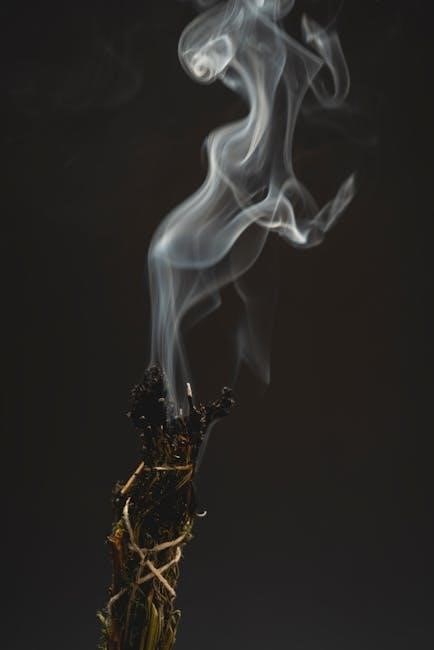
The Role of Skin Type in Fragrance Concentration
Skin type significantly influences fragrance longevity. Oily skin retains scents longer, while dry skin benefits from lighter concentrations. Balancing concentration with skin type enhances fragrance experience.
8.1 Oily Skin and Fragrance Retention
Oily skin naturally retains fragrances longer due to its higher sebum content, which slows evaporation. This allows scent molecules to linger, making stronger concentrations more suitable. However, heavy oils can alter fragrance notes over time. Balancing concentration with skin type ensures optimal performance and prevents overpowering effects. Lighter formulas may still work well, especially in warm climates, where excessive oil can amplify intensity. Understanding this dynamic helps in selecting the right fragrance strength for oily skin.
8.2 Dry Skin and Lighter Concentrations
Dry skin absorbs fragrances quickly, reducing longevity. Lighter concentrations, such as Eau de Cologne or Eau Fraîche, are ideal as they are less overpowering and won’t dry out the skin further. These formulas have higher water content, making them more suitable for dry skin. Applying smaller amounts regularly can help maintain the scent without irritation. Lighter fragrances also prevent the skin from feeling tight or flaky, ensuring a comfortable and subtle aroma throughout the day.
Fragrance Concentration and Allergies
Lower fragrance concentrations are often recommended for sensitive skin to minimize allergic reactions. Essential oils in higher concentrations can trigger skin irritation or respiratory issues in some individuals.
9.1 Lower Concentrations for Sensitive Skin
For individuals with sensitive skin, lower fragrance concentrations are essential to avoid irritation. Higher concentrations can trigger allergic reactions or discomfort due to potent essential oils. Opting for lighter formulations, such as Eau Fraîche or diluted fragrances, reduces the risk of adverse effects. Always patch test before widespread use and consider hypoallergenic options. Fragrance-free products may be the safest choice for highly sensitive individuals.
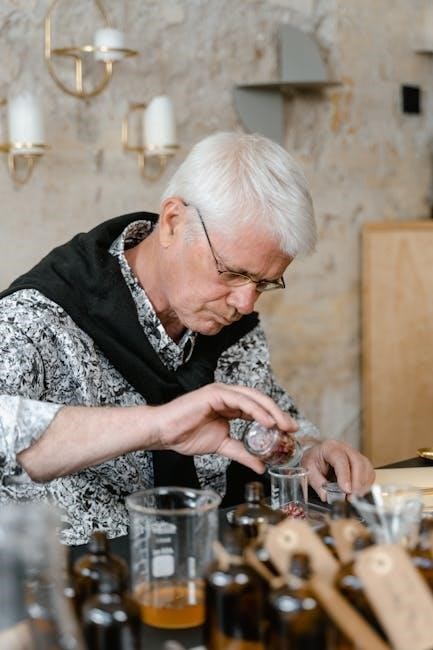
The Impact of Synthetic vs. Natural Ingredients
Synthetic ingredients offer consistent fragrance strength and affordability, while natural ingredients vary in concentration and quality, affecting scent intensity and longevity.
10.1 Natural Ingredients and Their Concentration Challenges
Natural ingredients often present volatility and variability, making consistent fragrance concentration difficult. Their potency can fluctuate based on sourcing, climate, and extraction methods, impacting final scent strength. Natural essences may require higher quantities to achieve desired intensity, increasing costs. Additionally, natural compounds can degrade faster, affecting longevity. This unpredictability challenges perfumers to balance fragrance concentration while maintaining quality and sustainability.

Cultural and Personal Preferences in Fragrance Concentration
Cultural and personal preferences significantly influence fragrance concentration choices, with regional traditions and individual lifestyles shaping preferences for stronger or lighter scents, impacting selection.
11.1 Regional Differences in Fragrance Strength Preferences
Regional differences play a significant role in fragrance strength preferences. Middle Eastern markets often favor intense, concentrated fragrances due to cultural and climatic factors. In contrast, European preferences lean toward nuanced, moderate concentrations. Asian markets sometimes prefer lighter, fresher scents, while Latin American countries often embrace bold, long-lasting fragrances. These variations reflect cultural norms, lifestyle, and environmental influences, shaping the demand for specific fragrance concentrations globally.
Floral Fragrances and Their Economic Value
Floral fragrances hold significant economic value due to high demand in perfumery. Essential oils from roses and jasmine are particularly prized, driving their premium pricing globally.
12.1 The Role of Floral Scents in Attracting Pollinators
Floral fragrances play a vital role in attracting pollinators like bees and butterflies. These scents are complex mixtures of volatile organic compounds (VOCs) that guide pollinators to nectar-rich flowers. The intensity and type of fragrance vary among species, ensuring specific pollinator attraction. For instance, strong, sweet scents often attract bees, while floral-citrus notes may draw butterflies. This natural communication system not only aids pollination but also inspires perfumery, where similar principles are used to create alluring fragrances for human use.
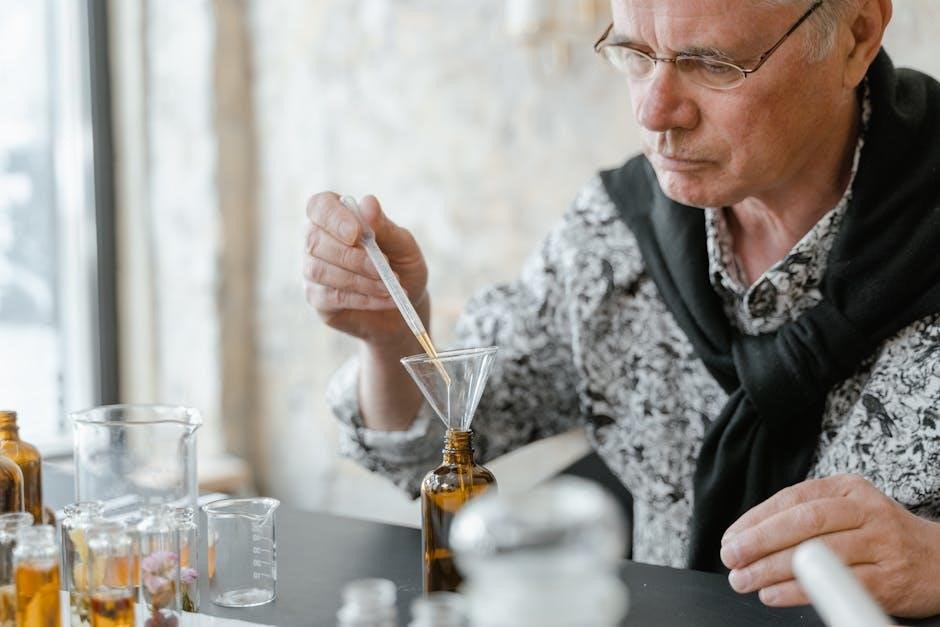
Sustainability in Fragrance Concentration
Sustainability in fragrance concentration involves eco-friendly practices, such as using responsibly sourced ingredients and reducing waste. This approach promotes environmental stewardship while maintaining fragrance quality and longevity.
13.1 Eco-Friendly Practices in Perfume Production
Eco-friendly practices in perfume production focus on sustainable sourcing of ingredients, reducing chemical usage, and minimizing waste. Brands adopt recyclable packaging and energy-efficient manufacturing processes. Natural, organic materials are prioritized to lower environmental impact. Some companies use biodegradable fragrance components and ethical labor practices, ensuring a greener footprint. These methods help preserve biodiversity and reduce carbon emissions, aligning with global sustainability goals while maintaining high-quality fragrances.
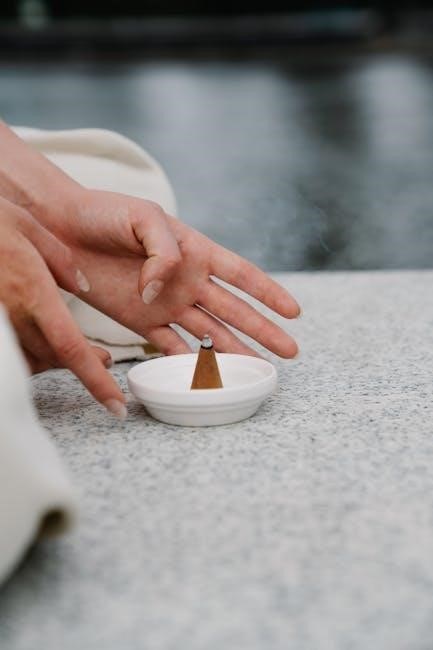
Application Tips for Different Concentrations
Apply parfum behind the ears and on the wrists for longevity. Use eau de toilette on pulse points for a subtle scent. Eau fraîche suits casual use.
14.1 How to Apply Parfum vs. Eau de Toilette
Parfum, being highly concentrated, should be applied sparingly to pulse points like wrists and behind the ears. Its richness makes it ideal for special occasions. Eau de toilette, with its lighter concentration, can be applied more generously, such as after shaving or on the neck and chest. For parfum, dabbing is preferred over rubbing to preserve fragrance intensity. Eau de toilette works well for everyday use, offering a fresh, subtle scent. Always consider skin type and occasion when choosing application methods.
Understanding fragrance concentration enhances personal scent experiences, balancing strength and longevity for perfect wear. Choose wisely to enjoy your signature aroma confidently, every day, in every moment.
15.1 Final Thoughts on Selecting the Right Fragrance Concentration
Selecting the right fragrance concentration is a personal journey, blending strength, longevity, and preference. Consider occasion, skin type, and scent longevity when choosing between Parfum, EDP, EDT, or Eau Fraîche. Lighter concentrations like Eau de Cologne are ideal for everyday use, while stronger options like Parfum offer depth for special moments. Experiment with layers and body products to tailor your fragrance experience. Ultimately, the perfect concentration enhances your enjoyment, ensuring your scent lingers beautifully while reflecting your unique style and confidence.



Leave a Reply
You must be logged in to post a comment.